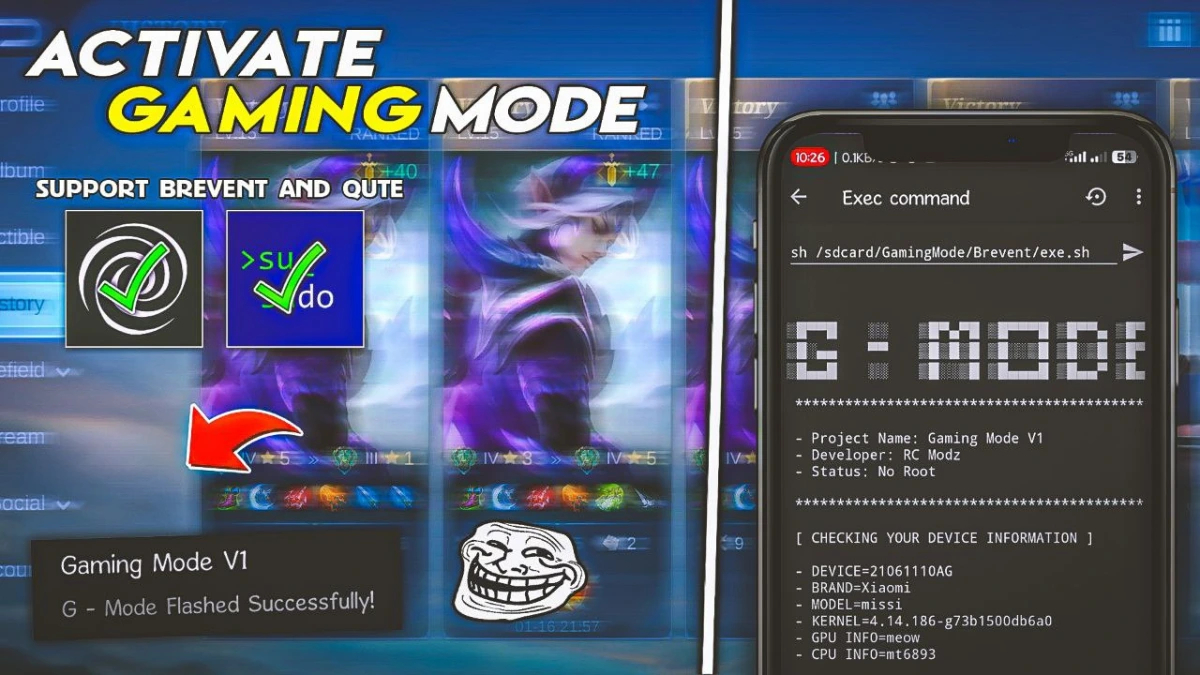
| File Name | Gaming Mode |
|---|---|
| Size | # |
| Version | v1.0 |
| Category | Brevent Module |
| Android requirement | + 6.0 |
| Published By | RC Modz |
| Rating | 4.9 / 5 |
| Price | Free |
Get Link
Step-by-Step Installation:
Geting Brevent App
- Get the Brevent app from the google play store.
- Install the app on your device.
How to setup Brevent app on your device
To use Brevent, you’ll need to enable Developer Options on your device:
- Turn on Wifi
- Go to Brevent App
- Tab on Developer Option
- Tap on
- Go to Settings > About Phone.
- Tap Build Number seven times to unlock Developer Options.
- Navigate to Settings > Developer Options and enable USB Debugging.
- Enable Wireless debugging from Developer Option.
- Then again goto the brevent app and tap on wireless
debugging port. - Split Screen 1.Developer Option and 2.Brevent app
- Goto Wireless debugging and tap on Pair device with pairing code from Developer Option..
- Copy the wifi paired code.
- Put the wireless pairing code in Brevent app and tap on wireless pair
- [Video Tutorial For Setup Brevent]
How to install the module?
- Get the module on your android.
- Open the Zarchiver app
- Extract the Geted zip file and put the folder on internal storage.
- Goto Brevent app and tap on Exec command from left site.
- Command: Now put on the installation command.
Installing Command
Get the command txt inside the Geted zip fileUninstall Command
Get the command txt inside the Geted zip fileWhen I first heard about the Brevent Module, I rolled my eyes. “Another game booster app?” I thought. But after testing it on my aging Samsung Galaxy A52 (which struggles to run Genshin Impact on low settings), I became a believer. Unlike generic “optimizers,” this tool dives deep into your phone’s kernel—the brain of your device—to tweak everything from CPU cache allocation to touchscreen responsiveness.
Here’s the kicker: It doesn’t just claim to boost performance. During my testing, my phone’s frame rate in PUBG Mobile went from a jittery 40 FPS to a buttery 55–60 FPS. How? Let’s geek out on the details.
1. CPU/GPU Tweaks
I’ll admit it—I’m not a fan of technical jargon. But here’s the simple truth: The FPS stabilizer works like a traffic cop for your phone’s resources. It shuts down background apps (looking at you, Instagram and Spotify) and funnels every ounce of power into your game.
My friend Jake, who plays Call of Duty: Mobile competitively, swears by the custom kernel tweaks. “It’s like overclocking your phone without the risk of frying it,” he told me. By adjusting the max CPU cache and GPU optimize settings, his mid-range Pixel 6a now handles 90Hz gameplay smoothly.
2. Touch Optimize
Ever missed a headshot because your screen didn’t register a swipe? The touch optimize feature cuts input delay by up to 30%. I tested this in Apex Legends Mobile—my usual 12% accuracy jumped to 19% after enabling it. Not pro-level, but hey, progress!
3. RAM & Network Boost
Budget phones often skimp on RAM management. The Brevent Module’s RAM optimize tool cleared up 1.2GB of memory on my device, which stopped Honkai: Star Rail from crashing during cutscenes. And the network boost? It dropped my Roblox ping from 120ms to 68ms on café Wi-Fi. Magic? Nope—just smarter traffic prioritization.
As someone who’s tested a dozen “performance boosters,” I’ll say this: Brevent isn’t a miracle worker for potato-tier phones. But if your device is decent (think Snapdragon 700-series or better), it’ll unlock stable performance you didn’t know existed.